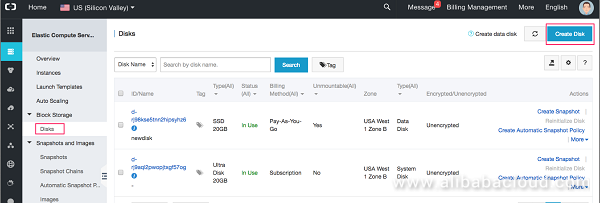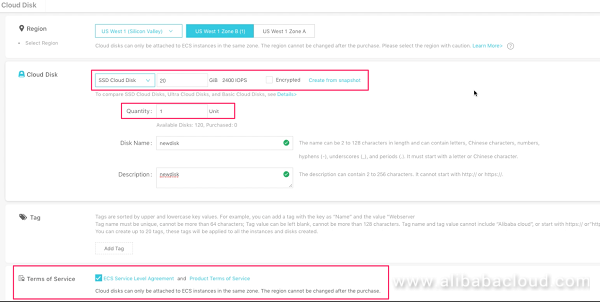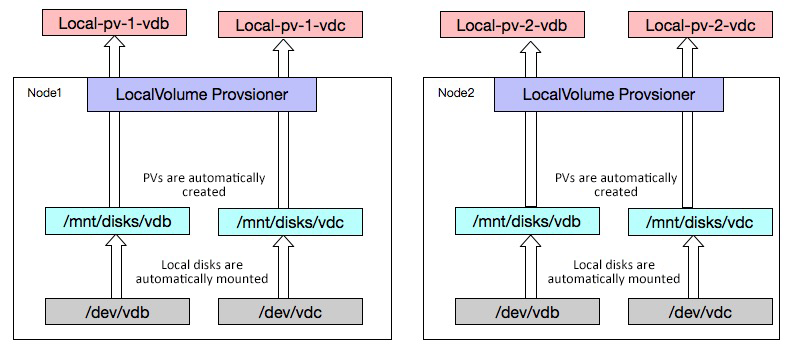In this article, we will learn how to create and attach a block storage disk onto an Alibaba Cloud ECS instance.
In Alibaba Cloud Elastic Compute Service (ECS) Linux servers, whenever you need to add additional storage capacity in an ECS server, adding disk is a possible and convenient solution. This tutorial is all about
Alibaba Cloud allows you to create a virtual block storage device (disks) that you can attach in to your virtual machines (ECS Instance).
Make sure you have a valid Alibaba Cloud account to try out this experiment. You'll also need an Alibaba Cloud ECS instance to follow the tutorial. The example shown in this document will only work on UNIX-based (Linux & OS X) machines which is running on Alibaba Cloud ECS instances.
Now let's get started on creating the first Volume.
In the Alibaba cloud ECS console dashboard, click the Disks menu under Block storage.

Select the following (this may vary based on user need)

In this article, we will install and configure FreeNAS on an Alibaba Cloud ECS instance.
FreeNAS is an open source network attached storage that is based on the FreeBSD and the OpenZFS file system. According to the official website, FreeNAS is an operating system that can be installed on virtually any hardware platform to share data over a network.
FreeNAS installation in Alibaba Cloud is an advanced level task and should be performed carefully. To begin with installation, there are several high-level steps needed to install and setting it up the FreeNAS on an Alibaba Cloud Elastic Compute Service (ECS) instance.
Make sure you have a valid Alibaba Cloud account to try out this experiment. You'll also need an Alibaba Cloud ECS instance to install FreeNAS. FreeNAS 11.1 requires a 64-bit CPU and a minimum of 8GB RAM.
FreeNAS is an operating system that can be installed on virtually any hardware platform to share data over a network.
FreeNAS is the simplest way to create a centralized and easily accessible place for your data. Use FreeNAS with ZFS to protect, store, backup, all of your data. FreeNAS is used everywhere, for the home, small business, and the enterprise.
FreeNAS 11.1 requires a 64-bit CPU and a minimum of 8GB RAM, this version can be download from here.
This article describes the various methods that you can employ to encrypt static data, including OSS, RDS, and ECS data encryption.
Data has become the new currency for many businesses of today as it can provide valuable insights into markets for organizations to gain an upper hand over their competition. However, access control methods such as Anti-DDoS and firewalls (WAF) alone are not enough; businesses need to protect their data through encryption as well. Encryption is necessary as it allows you to securely protect data and limit access to the data to only those with the correct security keys.
OSS supports client-side encryption and server-side encryption.
Client encryption means that the encryption is completed before the user data is sent to the remote server, whereas the plaintext of the key used for encryption is kept in the local computer only. Therefore, the security of user data can be ensured because others cannot decrypt the data to obtain the original data even if the data leaks.
OSS supports server-side encryption for the data uploaded by users: When a user uploads data, OSS encrypts the user data and permanently stores the data with encryption; when the user downloads the data, OSS automatically decrypts the encrypted data, returns the original data to the user, and declares in the header of the returned HTTP request that the data has been encrypted on the server.
For the details, see Server-side encryption.
RDS supports SSL and TDE encryption.
RDS provides Secure Sockets Layer (SSL) for MySQL and SQL Server. You can use the server root certificate provided by RDS to verify whether the database service with the target IP address and port is provided by RDS, which can effectively prevent man-in-the-middle attacks. To guarantee security and validity, RDS allows you to enable and update the SSL certificates for servers.
Though RDS can encrypt the connection between an application and a database, the SSL service can run properly only after the application enables authentication on the server. In addition, SSL results in extra CPU resource consumption and affects the throughput and response time of RDS instances to a certain degree. The specific impact varies depending on the number of user connection times and the data transfer frequency.
For more information about enabling and configuring SSL encryption service, see Set SSL Encryption.
In this article, we discuss the major pain points of data storage reliability and availability, and explore how enterprises can alleviate them through hybrid cloud backups.
Cloud storage has become the go-to solution for enterprise storage applications because of its reliability and security. Statistics show that AWS, Microsoft Azure, and Alibaba Cloud revenues have increased by 45.9%, 61%, and 126%, respectively. According to Gartner, IaaS continues to be the most promising growth field, with a projected growth of 28% in the next 5 years. However, major public cloud providers are not immune to accidents and disasters, which can lead to downtime in services.
In February 2017, an engineer at AWS accidentally entered an incorrect command line while trying to debug an S3 storage system in the data center located in Virginia, causing four hours of downtime. This affected many enterprise platforms including Slack, Quora, and Trello. In September, another storage accident occurred in this region (East US).
In March 2017, Microsoft Azure public cloud storage encountered availability issues for more than eight hours, during which a portion of customers located in eastern US were influenced.
In June 2018, an operation error during Alibaba Cloud maintenance caused some customers to encounter issues when they tried to access the console on the official Alibaba Cloud website and use some products.
In August 2018, Tencent Cloud, lost production data stored by several start-up companies due to a silent error resulting from a hard drive hardware bug.
Almost all major cloud providers have had similar production incidents. Does this indicate that public clouds are insecure?
Backup and disaster tolerance products/solutions are still the battlefield of traditional service providers. They provide rich products that cover a wide range of fields. Other cloud providers have relatively small input and output in this industry. In our opinion, traditional backup and disaster tolerance products have two problems:
For public cloud users, the backup and disaster tolerance ecosystems on clouds are incomplete. Even when backup and disaster tolerance software from traditional service providers are successfully deployed, it is hard to integrate them with existing resources on clouds for seamless monitoring and maintenance. Additionally, non-cloud-native backup and disaster tolerance may pose potential risks to users. Even though some backup and disaster tolerance products have been integrated into public clouds, traditional service providers may still fail to provide immediate response and support due to frequent releases and upgrades of products and features provided by public cloud providers. Therefore, users may not be able to take advantage of new features and performance improvements immediately when they are available. Finally, traditional service providers cannot implement internal coordination among various products while cloud providers can. Private cloud or hybrid cloud users also face the same problems.
Traditional backup and disaster tolerance products still target the ecosystem of traditional servers and storage. The lump-sum input in deploying one or more devices and designing solutions, both for the pay-by-node and pay-by-capacity payment models, is very costly for small and medium enterprises. The maintenance cost can even be higher than the initial input when device warranties or authorization expires.
Users' concerns and problems are our responsibilities. In addition to improving reliability of individual products and providing maintenance guarantees, each public cloud provider has the obligation to provide cost-effective, easy-to-use, and efficient disaster tolerance solutions. More public cloud users means stronger disaster recovery needs. Hybrid Backup Recovery, Cloud Storage Gateway, and Hybrid Disaster Recovery from Alibaba Cloud's hybrid cloud storage team can provide users with perfect disaster tolerance solutions. These products are solutions for customers needing hybrid cloud disaster recovery from local IDCs to Alibaba Cloud or cross-cloud disaster recovery (multi-cloud disaster recovery) from other cloud providers to Alibaba Cloud. This article mainly shows how the three products from Alibaba Cloud's hybrid cloud storage team react to the cross-cloud disaster recovery (multi-cloud disaster recovery) scenario.
In this article, we'll explore how to use and configure Alibaba Cloud local disks in a Kubernetes system using LocalVolume.
Introduction
Alibaba Cloud provides local disk configurations for some Elastic Compute Service ECS instances. Local disks have the advantages of low latency, high random IOPS, high throughput, and high cost effectiveness, and has great advantages in some applications with high performance requirements.
In the Kubernetes system, local disks can be used through HostPath, LocalVolume, and other types of PV.
This document describes how to use the Alibaba Cloud local disk using LocalVolume.
To learn more about ECS local disks, refer to Local disks
Local disks cannot be mounted or unmounted;
Local disks and ECS must coexist. The number of local disks is determined when ECS is created;
The type of the machine determines the number of local disks, which can be obtained through API;
By default, local disks are mounted from /dev/vdb, which may be different from custom images.

Provisioner mounts local disks to the target directory at startup:
The number of local disks in this machine can be queried through API;
Local disks are mounted from the initiating device (/dev/vdb, by default) to the target directory in turn (the initiating device can be configured);
The device detects the file system. If the device does not format the file system, a file system is created;
Provisioner polls and checks the target directory in real time, and creates a PV based on the target directory list:
When a PV is created, StorageClass can support the configuration of reclaimPolicy and volumeBindingMode;
After LocalVolume PV is deleted, it is automatically created again;
PV name: local-pv-{node name}-{device Name}. The PV name will be added to the label;
This is a step by step operations demonstration on how to resize ECS data disk and change system disk
For more details of ECS product, please access here
To know more about ECS, you can also visit our online clouder course here
This is a step by step operations demonstration on how to use snapshot to do ECS data disk backup and recovery
For more details of ECS product, please access here
To know more about ECS, you can also visit our online clouder course here
This is a step by step operations demonstration on how to resize ECS data disk and change system disk
Websoft9 WAMPServer stack is a pre-configured, ready to run image for running PHP application on Alibaba Cloud.
Websoft9 WordPress is a pre-configured, ready to run image for running WordPress on Alibaba Cloud.
This topic describes the concepts of a storage package and storage capacity. It also provides details about the procedure to view the storage capacity of a file system.
The billing method for a storage package is subscription.
Assume that you create a NAS Capacity file system and link a storage package with a size of 500 GB to the file system. During a period from 7:00 to 8:00 on June 1, 2019, the maximum used capacity of the file system is 550 GB. When you are charged, 500 GB of the total 550 GB is covered by the storage package, while the remaining 50 GB is charged by using the pay-as-you-go billing method.
](https://www.alibabacloud.com/help/doc-detail/62474.html)
Realtime Compute provides a management page for various data storage systems, such as ApsaraDB for RDS and Table Store. It offers you a one-stop cloud-based management solution.
In Realtime Compute, data storage has the following two meanings:
Alibaba Cloud Elastic Compute Service (ECS) provides fast memory and the latest Intel CPUs to help you to power your cloud applications and achieve faster results with low latency.
Block-level data storage attached to ECS instances to achieve high performance, low latency, and high reliability
Simple, scalable, on-demand and reliable network attached storage for use with ECS instances, HPC and Container Service.
What is Data Analysis? Methods, Process, Examples, Techniques

2,598 posts | 769 followers
FollowCherish Wang - January 17, 2019
ApsaraDB - August 6, 2019
Yen Sheng - April 3, 2023
Alibaba Clouder - December 16, 2019
Cherish Wang - February 20, 2019
Alibaba Clouder - August 20, 2020

2,598 posts | 769 followers
Follow OSS(Object Storage Service)
OSS(Object Storage Service)
An encrypted and secure cloud storage service which stores, processes and accesses massive amounts of data from anywhere in the world
Learn More Cloud Storage Gateway
Cloud Storage Gateway
Cloud Storage Gateway uses OSS for cloud-based storage at the back end, and supports standard file and block storage protocols in the industry.
Learn MoreMore Posts by Alibaba Clouder
Start building with 50+ products and up to 12 months usage for Elastic Compute Service
Get Started for Free Get Started for Free